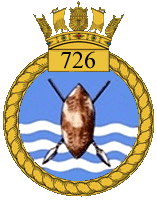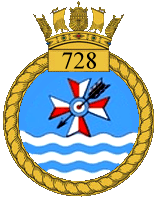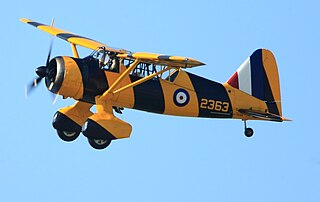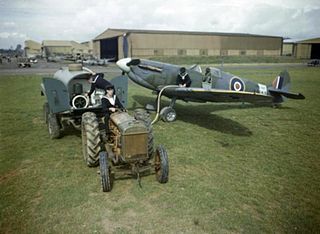
Royal Naval Air Station Lee-on-Solent,, is a former Royal Naval Air Station located near Lee-on-the-Solent in Hampshire, approximately 4 miles (6.44 km) west of Portsmouth, on the coast of the Solent.

737 Naval Air Squadron was a Naval Air Squadron of the Royal Navy's Fleet Air Arm. It was initially active during 1943 as an amphibious Bomber Reconnaissance Training Squadron. Reactivated in 1944 it operated as an ASV Training Unit until 1945. It was active again between 1949 and 1957. From 1959 it was the Anti-Submarine Warfare school at RNAS Portland. It operated Westland Wessex HAS.3 rescue helicopters from their land base at RNAS Portland, Dorset.

717 Naval Air Squadron was a Naval Air Squadron of the Royal Navy's Fleet Air Arm which last disbanded in March 1946. It formed as a Torpedo Bomber Reconnaissance Training Squadron, at HMS Owl, RNAS Fearn, in July 1944, operating with Fairey Barracuda torpedo bomber aircraft. The squadron then moved to HMS Merganser, RNAS Rattray, in the October, continuing in Torpedo Bomber Reconnaissance training. In early 1946 the squadron received Blackburn Firebrand aircraft, with the objective of forming a Firebrand Conversion Unit, but this was never realised.

719 Naval Air Squadron was a Naval Air Squadron of the Royal Navy's Fleet Air Arm. It initially formed in 1944 as a Fighter Air Firing Training Squadron, at RNAS St Merryn, within the School of Air Combat. At the start of 1945 the squadron disbanded into 794 Naval Air Squadron. The squadron reformed in 1946 at RNAS Fearn as a Strike Training Squadron, before moving to RNAS Eglinton, where it became an Anti-submarine Training Squadron, disbanding there in 1949.

726 Naval Air Squadron was a Naval Air Squadron of the Royal Navy's Fleet Air Arm. It was formed as a Fleet Requirements Unit from 1943 to 1945, operating out of R.N. Air Section Durban, at S.A.A.F. Station Stamford Hill, Durban, South Africa, during its existence. It operated various aircraft including, Bristol Beaufighter, Boulton Paul Defiant, Fairey Fulmar, North American Harvard, Vought Kingfisher, Miles Martinet and Fairey Swordfish.

728 Naval Air Squadron was a Naval Air Squadron of the Royal Navy's Fleet Air Arm. It was formed at the beginning of May in 1943, as a Fleet Requirement Unit, at RNAS Gibraltar. It provided detachments at Tafaraoui, in Algeria and later at Oujda in Morocco. Moving to RNAS Dekheila, in Egypt, during June, it then merged into 775 Naval Air Squadron during July.
730 Naval Air Squadron was a Naval Air Squadron of the Royal Navy's Fleet Air Arm. It was active between 1944 and 1945 as a communications squadron. The squadron was formed and operated out of RNAS Abbotsinch from April to November 1944, by that point in time it operated four types of aircraft. It moved to RNAS Ayr and while there gained two more aircraft types. For the first three months of 1945 a detachment operated out of RNAS Machrihanish, however, the squadron remained at RNAS Ayr until disbanding in August 1945.
735 Naval Air Squadron was a Naval Air Squadron of the Royal Navy's Fleet Air Arm. It was active between 1943 and 1946 as an ASV radar Training Unit. Forming at RNAS Inskip in 1943, roughly one year later the squadron moved to RNAS Burscough. Various flights from the squadron moved on to form other Naval Air Squadrons, with 735 NAS eventually disbanding in 1946.
741 Naval Air Squadron was a Naval Air Squadron of the Royal Navy's Fleet Air Arm. It was initially active, between 1943 and 1945 as an Observer Training Squadron at RNAS Arbroath. It reformed at RNAS St. Merryn, as an Operational Flying Training Unit in 1946.
742 Naval Air Squadron was a Naval Air Squadron of the Royal Navy's Fleet Air Arm. It was active as a Communications Squadron and a Royal Navy Air Transport Squadron, operating in Sri Lanka during and after World War II.

752 Naval Air Squadron was a Naval Air Squadron of the Royal Navy's Fleet Air Arm. Formed in May 1939, at RNAS Ford as an Observer Training Squadron, it was active through to 1945 as part of No. 1 Observer School. Ford was attacked in August 1940 and the squadron moved to RNAS Lee-on-Solent for a one month stay. From November 1940, through to disbandment in October 1945, it operated at RNAS Piarco , Trinidad.

753 Naval Air Squadron was a Naval Air Squadron of the Royal Navy's Fleet Air Arm. It was active as an Observer Training Squadron from 1939 to 1946 as part of No.2 Observer School, forming out of the School of Naval Co-operation, in May 1939. Initially at RNAS Lee-on-Solent, the squadron moved to RNAS Arbroath just over one year later, in August 1940, following a German bombing attack on the air station. It spent four years operating out of Arbroath, before relocating again, this time to RNAS Rattray, where the squadron disbanded in August 1946.

754 Naval Air Squadron was a Naval Air Squadron of the Royal Navy's Fleet Air Arm. It was active as an Observer Training Squadron from 1939 to 1944 as part of No.2 Observer School, forming out of the School of Naval Co-operation, in May 1939. It initially operated out of RNAS Lee-on-Solent, however, after the Naval Air Station was attacked and bombed, it then moved to RNAS Arbroath, in September 1940. Here, it provided training for Observers and also Air Gunners and where four years later, in March 1944, it disbanded. The squadron then briefly reformed as a Training Squadron, as part of No. 1 Naval Air Gunners School, when 744 Naval Air Squadron was re-designated 754 Naval Air Squadron, in June 1944, at RN Air Section Yarmouth, Nova Scotia, Canada, untildisbanding again, in March 1945.

756 Naval Air Squadron was a Naval Air Squadron of the Royal Navy's Fleet Air Arm. It was initially formed as a Telegraphist Air Gunner Training Squadron, operating from March 1941, out of RNAS Worthy Down, in Hampshire, England. TAG training was provided until the No. 2 School was ready in Canada, opening on the 1 January 1943, and 756 NAS disbanded in December 1942. The squadron reformed at RNAS Katukurunda, in Sri Lanka, in October 1943, as a Torpedo, Bomber, Reconnaissance pool. During 1944 and 1945, the squadron undertook a number of detachmemts on different types of Royal Navy aircraft carriers, with it disbanding in December 1945.

761 Naval Air Squadron was a Naval Air Squadron of the Royal Navy's Fleet Air Arm. It was formed at RNAS Yeovilton, as a Fleet Fighter School, in 1941. The squadron moved to RNAS Henstridge, in 1943, as part of the No. 2 Naval Air Fighter School. It remained at Henstridge and in this role, until January 1946, when the squadron disbanded.

763 Naval Air Squadron was a Naval Air Squadron of the Royal Navy's Fleet Air Arm. It formed in 1939 as the Torpedo Spotter Reconnaissance Pool No. 1, at RNAS Worthy Down. Three months later, it moved to the short-lived RNAS Jersey, before moving back to Worthy Down via RNAS Lee-on Solent and disbanding in 1940. The squadron reformed, on the seaplane carrier HMS Pegasus, as a Seaplane Training Squadron, in 1942. This role lasted around two years and the squadron continually operated and provided training from HMS Pegasus, until disbanding in 1944. Roughly two months later, the squadron reformed again, this time at RNAS Inskip, as an Anti-submarine Operational Training Squadron and remained in this role for just over one year, disbanding in July 1945 at Inskip.

765 Naval Air Squadron was a Naval Air Squadron of the Royal Navy's Fleet Air Arm. It formed at RNAS Lee-on-Solent, in May 1939, as a Seaplane School and Pool squadron. The squadron moved to RNAS Sandbanks, in August 1940, where it undertook the Seaplane Flying Training Course Part I. Lieutenant Commander Wilson was appointed as dual officer in charge of the air base, and Commanding officer of 765 NAS. By the middle of 1943, dedicated Seaplane Training schools ended and the squadron disbanded in the October. 765 NAS reformed at RNAS Charlton Horethorne, in early February 1944, as a Travelling Recording Unit. The squadron moved to RNAS Lee-on-Solent in March, before moving to RNAS Worthy Down on one month later during April, then in May it moved to RNAS Stretton, were it remained during June.
793 Naval Air Squadron was a Naval Air Squadron of the Royal Navy's Fleet Air Arm. It was formed in 1939 at RNAS Ford and remained active throughout to 1945, as an Air Towed Target Unit, as part of No.1 Observer School. From 1940 to disbandment it operated at RNAS Piarco, Trinidad.

Royal Naval Air Station Twatt, is a former Royal Navy Air Station located near Twatt, Orkney, Scotland. It was built by the Admiralty and was commissioned on 1 April 1941. On 1 January 1942 it became an independent command as HMS Tern. The airbase was designed to provide accommodation for disembarked Front-Line squadrons and accommodation for disembarked Ship's Flight Aircraft and was home to the Home Fleet Fleet Requirements Unit, 771 Naval Air Squadron.















